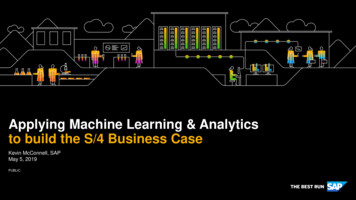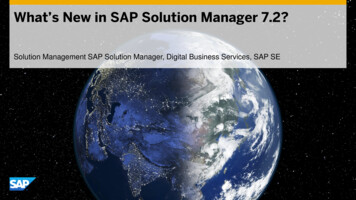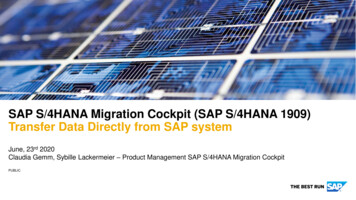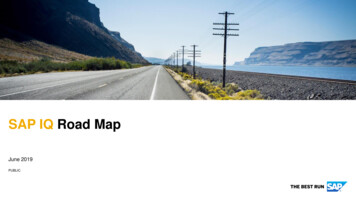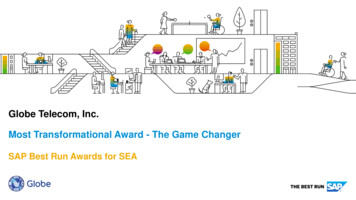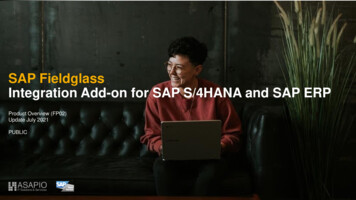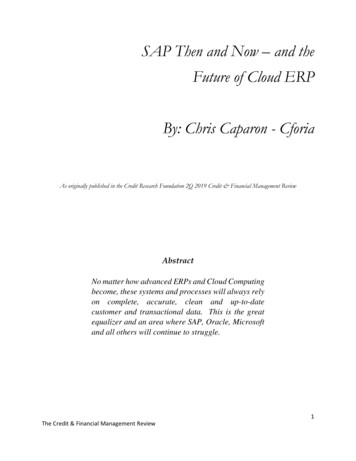
Transcription
SAP Then and Now – and theFuture of Cloud ERPBy: Chris Caparon - CforiaAs originally published in the Credit Research Foundation 2Q 2019 Credit & Financial Management ReviewAbstractNo matter how advanced ERPs and Cloud Computingbecome, these systems and processes will always relyon complete, accurate, clean and up-to-datecustomer and transactional data. This is the greatequalizer and an area where SAP, Oracle, Microsoftand all others will continue to struggle.1The Credit & Financial Management Review
In 1972, non-mainframe Enterprise Requirements Planning (ERP) systems were born.Five Engineers (Hasso Plattner [current SAP CEO], Dietmar Hopp, Klaus Tschira, , HansWerner Hector, and Claus Wellenreuther) working for IBM in Germany left to start a newcompany with a very different approach to enterprise computing. They called their company“System Analysis and Program Development” – SAP.Another big milestone you might remember from 1972: the arcade game “PONG” was released– a very significant birth of a completely different kind of human activity – particularly for ourchildren.20% Others 1% EachSAP, 28%Others 1% EachIFS, 2%Oracle, 15%Epicor, 5%Infor, 7%Microsoft, eOthersToday, 47 years and 413,000 customers later, SAP dominates the global EnterpriseRequirements Planning (ERP) landscape (Data from CRF/Cforia Webinar “Rewind to the 70’swhen mainframes ruled and the Rolling Stones Rocked” - mand-webinar)Most CRF Member companies today are either using SAP or are being affected by one of theircustomers who is using SAP in some part of their business operation.2The Credit & Financial Management Review
Back in 1973 the first SAP product released was called SAP R/1 (many companies around theworld are still running R/1 today – which is fine, especially if you really like green-screens). R/1was a tremendous breakthrough for non-mainframe Payroll and Accounting software. The mainadvantages were two-fold:1) SAP R/1 did not require COBOL Punch-Cards, which was the norm at the time. This wasa big deal and thus the “R” for ‘Real-Time’ computing was evolving.2) SAP created a new ‘Logical Database’ from which to access and process SAP dataelements. This was another big deal at the time and recently the new SAP In-MemoryHANA RDBMS (Relational Database Management System) has taken another major leapforward in ERP processing speed and data processing power.“The S/4HANA finance application, can drink data more than10-fold.” Hasso Plattner, SAP Chairman/FounderKeep in mind, the 1972 SAP R/1 system ran on IBM computers using a DOS (Disk OperatingSystem) with a whopping 8KB (8,000 Bytes) of Random Access Memory (RAM). The averageSmart Phone we carry today runs on 6GB (6,144,000,000 Bytes) of RAM, and many cell phoneshave 12GB of RAM.In 1973 SAP released R/98, the ‘first commercial ERP system’ on the market, which featuredcentralized data storage with common systems and process capability. This was followed in 1979by SAP’s R/2, which had expanded capability for inventory, supply chain management andmanufacturing. In 1992 SAP R/3 was delivered and went through six releases ending in 2003with R/3 Enterprise release 4.70.If we took a CRF survey today, we would find a surprising number of companies still running onthis fifteen year-old SAP software version but you are not alone - there are still a lot of oldIBM AS400 computers out there running custom legacy RPG software.In 2004 SAP ECC 5.0 (SAP ERP Central Component Release 5) hit the market and was called‘mySAP ERP 2004’. The combined releases of SAP’s ECC are SAP’s biggest revenue generatorsand have been for some time. These software releases delivered enhanced modules for Financials(FI), Material Management (MM), Human Capital Management (HCM) and several otherenterprise department offerings through SAP acquisition and internal development.From 2005 to 2009 SAP ECC6 (mySAP ERP 2005), SAP further enhanced their ERP offeringswith the introduction of SAP Financial Supply Chain Management (FSCM), which included:3The Credit & Financial Management Review
SAP Treasury and Risk Management (FIN-FSCM-TRM)SAP Biller Direct (FIN-FSCM-BD) (Sunsetted product)SAP In-House Cash (FIN-FSCM-IHC)SAP Cash and Liquidity Management (FIN-FSCM-CLM)SAP Collections Management (FIN-FSCM-COL)SAP Credit Management (FIN-FSCM-CR)SAP Dispute Management (FIN-FSCM-DM)While all this SAP global Enterprise Requirements Planning (ERP) evolution was taking place,other technology companies were jumping into the fray and creating a vibrant and competitiveERP marketplace, which is estimated by Allied Market Research to be worth almost 42B by theend of next year: “ERP Software Market Report, published by Allied Market Research, forecaststhat the global market is expected to garner 41.69 billion by 2020, registering a CAGR of 7.2%during the period 2014-2020.”Not one to be left out of the party, Larry Ellison co-founded the Oracle Corporation in 1977 andtoday Oracle has a Market Cap over 180 billion. Oracle delivered the first commercial SQLRDBMS (Structured Query Language Relational Database Management System). ‘SQL’ meantthat you could reach many data records with a single program command, plus you did not haveto programmatically specify how the system was going to access that desired data element,which saved lots of coding. This was a huge improvement for software developers.Yes, today Oracle will tell you that their latest offering ‘Oracle NoSQL’ (or ‘Not Only SQL’ as itactually can use both) is vastly superior to SAP’s new HANA RDBMS, particularly for “BigData” applications. But SAP will tell you that SAP HANA (High-performance AnalyticAppliance) is vastly superior to Oracle’s NoSQL for Cloud-Based Software-as-a-Service (SaaS).The truth is, Oracle and SAP’s new offerings are both exciting technological advancements andwill both drive many new things including A LOT OF MONEY for not only Oracle and SAP,but all the System Integrators (SI’s) and Consulting Firms who satellite global enterprisesoftware providers.It is true that almost every software solution appears to be moving to the Cloud (Software-as-aService provided over the Internet), as every major player in the ERP space has Cloud offeringstoday and these offerings are only growing/moving faster to SaaS for many beneficial financial,operations and technological reasons.Let’s not forget the other major and growing force in the ERP space. . . Microsoft.In 1975 Bill Gates and Paul Allen founded Microsoft in Albuquerque, New Mexico. TodayMicrosoft has a Market Cap in excess of 970 billion. Although Microsoft still lags behind SAP4The Credit & Financial Management Review
and Oracle in ERP Marketshare, a trillion dollars can buy a lot of market penetration, which isexactly what Microsoft did and is continuing to do.Microsoft’s ERP offerings come in five flavors:1. Microsoft Dynamics AX - Large enterprise ERP. Microsoft acquired NavisionDamgaardfor 1.45B in 2002, then put in a lot of R&D and released Microsoft AX2012 in 2011 todirectly compete with SAP and Oracle2. Microsoft Dynamics GP - Mid-Market ERP. Microsoft purchased Great Plains (GP) in2001 for 1.1B for this ERP offering3. Microsoft Dynamics NAV - Navision was a leading mid-market ERP in Europe.Microsoft bought both the foundational software for AX and NAV with the sameNavisionDamgaard purchase4. Microsoft Dynamics SL - Construction and Contracting industry software5. Microsoft Dynamics C5 - Both SL and C5 are primarily small company specialized ERPproducts designed to compete with other similar market offerings like QuickBooks.At the same time all these ERP software evolutions were happening, there was a sea changetaking place with respect to computer technology, specifically the systems that ran these ERPs,or rather the ‘cost of computing’ as it related to the machines needed for the ERPs.There was a great article published by Chris Burniske, ARK Analyst, in 2014 titled: “TheEvolution of Storage: From Hard Disk Drives to Resistive RAM” which includes this graphic. Ittracks the inflation adjusted cost per Megabyte ( /MB) from 1956 to 2012.5The Credit & Financial Management Review
A ‘fast’ HDD (Hard Disk Drive) can read and write sequential data (non-random) at about125MBps (Megabytes per second). SSD (Solid-State Disk with no spinning disk) reads andwrites at speeds roughly 425% faster. So, if your Credit and Collections team is still processingdata on spinning disks, get IT to give your team a cost-effective boost in performance byswitching to SSD.There was also a new storage medium created called Flash Memory (FLASH) coming onto thescene. FLASH is a specialized SSD, or a non-volatile (reliable) computer storage medium.Toshiba developed the first FLASH in the early 1980s and called it EEPROM (ElectricallyErasable Programmable Read-Only Memory) and released it in 1984.So, during all this ERP software revolution taking place, the demand for bigger and faster datahandling capability the actual costs of computing power in terms of /MB of storage wasdramatically falling. In the chart above, Chris Burniske tracks the costs going from 1,000.00 perMegabyte in 1972 when SAP got started, to under 0.0001 per Megabyte by 2012.These technology advancements and the associated cost reductions were huge enablers ofsoftware solutions being available (and enterprises deciding to go) onto Cloud offerings in theform of Software-as-a-Service (SaaS). In addition to the highly-secure, specialized andperformance increasing offerings, the primary benefit is the cost savings of a company nothaving to buy all the hardware and maintain large datacenters and IT staffs to keep all thesemission-critical systems running 7/24/365 and safe from intrusion.You may have heard of Platform-as-a-Service (PaaS) with offerings like Oracle Cloud, AmazonWeb Services (AWS), Google Cloud Services Platform, Microsoft Azure and Salesforce. TheGartner Group projects this market reaching in excess of 400 billion by 2020. The informationplatforms used typically operate in High-Capacity Infinitely-Scalable, SSAE16 SOC1-SOC3secured and certified Co-Location Data Facilities. These information infrastructure co-locations(Co-Los), use very specialized Virtual-Servers running High-Availability, Redundant Fail-Over,Fault-Tolerant, Secured and Certified systems.Sorry, I love technology and these data-points do help give perspective to all the changes youhave been hearing about within the software industry. Plus, all these changes directly affect yourjob and the information tools your order-to-cash teams use to manage your Book-ofBusiness which is typically the #1 or #2 Working Capital Current Asset on your company’sBalance Sheet.All this technology advancement is a critical requirement and central dynamic that is literallyenabling the next evolution of SAP’s ERP software to the new In-Memory HANA (Highperformance Analytic Appliance) Relational Database. To give you an idea of what that means,26 separate SAP ECC6 data tables will be consolidated to just one master S/4HANA (S4H) datatable and SAP is estimating up to 30 times the data processing speed.6The Credit & Financial Management Review
Remember the SAP CEO quote above: “The S/4HANA finance application, can drink data morethan 10-fold.” That translates into the new SAP ‘In-Memory’ solution running ten-times thespeed and increased power to handle an ever-increasing amount of enterprise data. In fact, SAPis betting its future on it.as they are ending support for all predecessor SAP ERP softwarereleases in 2025, which is not that far away, especially considering the time it took to get yourcurrent software to work properly for your enterprise.So, what does the future hold for SAP and ERP systems in general?There is a great paper written by John Erik Ellingsen, the Managing Director of the SAPBusiness Group for Accenture, titled: “Unleashing Exponential Evolution – 2019 ERP Trends”.In the introduction titled “How to unleash the potential of your digital initiatives with intelligentERP”, Ellingsen points out that CIOs will be focused on their ability to “empower theirorganization to be future-aligned and core-nimble to chase business ambitions.” In other words,don’t let IT stand in the way of business progress. That sounds great!In a recent Accenture survey, they found that more than 50% of CIO’s said they preferredPrivate Cloud and this is consistent with Forrester research “CIOs and the Future of IT”.In Ellingsen’s paper he identifies these five (5) trends which he considers “fundamentallyimportant.”“TREAT CLOUD AS THE GATEWAY TO MODERNIZATION: Develop a nuancedcloud strategy that suits your business ambitions. Engineer cloud as part of a larger strategyaround digital transformation, cost savings and new business models.MAKE YOUR CORE INTELLIGENT AND EXTENDED: Invest in intelligence andautomation – powered by AI, machine-learning, and analytics: not as an add-on but as a corepart of your ERP platform. Enable your business to extend at scale and in real-time.PARTNER WITH CLOUD CAPTAINS, NOT TRADITIONAL SERVICES FIRMS:Find co-creation partners that differentiate by reimagining services delivery models, beingtechnology agnostic, and specializing in your business.PERSONALIZE: Make user experience (UX) seamless across channels and platforms andpersonalize relentlessly.AMPLIFY INSIGHTS BY CONVERGING DATA: Treat data as an asset. Free up thedata in your ERP systems and converge different data sources for deeper intelligence.”7The Credit & Financial Management Review
The way I interpret these solid Accenture insights is:1. Cloud Computing is here, every major ERP offering has it and this software trend is onlyaccelerating. If over 50% of CIOs already prefer Private Cloud Computing, see if you cancapitalize and take advantage of available modernizing technology to help you and yourstaff improve order-to-cash procedures, processes and results. Cash is King and yourdepartment controls the #1 or #2 Current Assets on your company’s Balance Sheet.2. OK, it is only natural that the lead SAP ERP guy at Accenture would determine that ‘coreERP’ is the way to go. Most Consulting companies and big System Integrators will also.As an “add-on” or “bolt-on” provider, focused on one critical working capital element,point-products for Credit, Collections, Disputes and Cash Application offer a great deal ofadvantage over ERPs. Let’s chat.3. Completely agree. Find order-to-cash specialists who offer tools that work with yourcurrent environment. Being agnostic to ERP, Billing System, System of Record, Systemof Engagement, Imaging System, etc. This offers you a tremendous amount of flexibilityand faster time-to-value to help prove your ROI (return on investment) to yourmanagement.4. Whatever you do to modernize, it has to be easy to use and easy to customize (configure)so that it gets adopted and becomes second nature. This is especially true for software. Ifyour team or our customers find the technology experience complicated rather thanintuitive, you will miss the mark of getting the results that you want.5. 100% correct - “Treat Data as an Asset.” The accuracy of your Customer Intelligence(everything related to Customer Master Data) will make or break your order-to-cashoutcomes.a. If your Customers do not trust the data they see in your Customer Self Service Portal,or it is not a complete picture of the business they do with your global company, theportal will fail.b. If your Collectors do not trust the accuracy and timeliness of the data, they will wastea great deal of time self-gathering the data they need.c. If you want to use Artificial Intelligence, Learning Algorithms and Robotic ProcessAutomation to propel your team to great capacity and accuracy, the ‘Data’ has to becomplete, timely and it has to be clean.Charles Babbage (1791-1871) was a mathematician, mechanical engineer and inventor whooriginated the concept of a digital programmable computer. In his writing he relates beingasked:“Pray, Mr. Babbage, if you put into the machine wrong figures, will the right answers comeout?”8The Credit & Financial Management Review
Although this exchange occurred some hundred and sixty years ago, it is an extremely poignantcommentary on the prowess of today’s latest FinTech (Financial Technology) - particularlywhen it comes to Artificial Intelligence (AI), Learning Algorithms and Robotic ProcessAutomation (RPA).At some point in the 20th century the phrase GIGO (Garbage In, Garbage Out) was coined and itkeeps coming up every day in our order-to-cash business lives.If you do not have a complete Customer Master Record (Customer Intelligence) across all yourGlobal Business Units and Systems of Record (ERPs), with an accurate Parent/Child Hierarchyrolling-up your Global Exposure, calculated with Clean-Receivables (without Disputes,Deductions, Authorized Returns, Credits, Trade Funds Co-Op, Payment Promises, etc.), your AI,Algorithms and Workflow will fail and cause you countless hours of rework to correct the errors.No matter how advanced ERPs and Cloud Computing becomes, these systems and processes willalways rely on complete, accurate, clean and up-to-date customer and transactional data. This isthe great equalizer and an area where SAP, Oracle, Microsoft and all others will continue tostruggle.Chris Caparon is the CEO of Cforia Software and has over 20 years of enterprise softwareexperience. Chris is a frequent industry speaker for CRF, ICTF and the Hackett Group, onthe subjects of improving working capital outcomes in Credit, Collections, Disputes, CashApplication and OTC Workflow Automation. Chris Caparon has led the implementations ofover 200 Order-to-Cash (OTC) Improvement Projects globally, integrating real-time dataacross multiple billing systems to create a single productivity platform for improving the focusand effectivity of regional and global financial shared service operations and personnel.Chris has double engineering degrees from the University of Michigan in both ElectricalEngineering and Computer Engineering.9The Credit & Financial Management Review
Epicor, 5% IFS, 2% SAP Oracle Microsoft Infor Epicor IFS QAD Lawson Consona Activant NetSuite Sage . Human Capital Management (HCM) and several other enterprise department offerings through SAP acquisition and internal development. From 2005 to 2009 SAP ECC6 (mySAP ERP 2005), SAP further enhanced their ERP offerings


